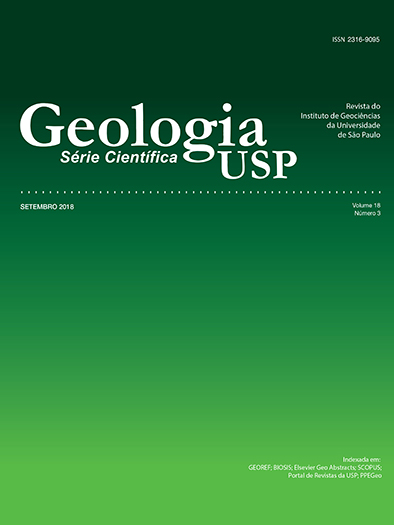Anisotropy and hydraulic confinement of the Guarany Aquifer system in Ribeirão Preto (SP, Brazil)
DOI:
https://doi.org/10.11606/issn.2316-9095.v18-128529Keywords:
Guarani Aquifer System, Pumping Test, Confinement, Anisotropy, Ribeirão PretoAbstract
A constant-rate pumping test executed during 171 h in the Guarani Aquifer System (GAS) was used to determine its respective hydraulic parameters and to test the existence of a drainage through an 84-m basalt layer (Serra Geral Aquitard), and the underlying sediments of the Corumbataí Formation. The test was prformed in a pumping well with hydraulic load monitoring in two minucipalities of Ribeirão Preto (São Paulo State, Brazil), located 10 km south of it. Results show a lack of drainage, and the positioning of the piezometers, in two distinct directions relative to the pumping well, allowed to infer the existence of anisotropy of the hydraulic conductivity. The calculated hydraulic parameters, after data correction for the pumping well’s partial penetration and for the aquifer’s anisotropy, are a hydraulic conductivity of 5,3x10-6 m/s and 8,1x10‑6 m/s, and storativity of 1,6 × 10-3 e 8,4 × 10-4, respectively for piezometers PPE-1G and PPE-2G. Maximum transmissivity, Tx = 1,9 × 10-3 m2/s, occurs along the N-S direction, and minimum transmissivity, Ty = 1,2 × 10-3 m2/s, sits along the E-W direction. On the horizontal plane, the relation between maximum and minimum transmissivities is 1,55. Drawdown does not stabilize during pumping, indicating that leakage through the basalts and through Corumbataí Formation was not sufficient to compensate for the discharge, or is nonexistent.
Downloads
Downloads
Published
Issue
Section
License
Authors who publish in this journal shall comply with the following terms:
- Authors keep their copyright and grant to Geologia USP: Série Científica the right of first publication, with the paper under the Creative Commons BY-NC-SA license (summary of the license: https://creativecommons.org/licenses/by-nc-sa/4.0 | full text of the license: https://creativecommons.org/licenses/by-nc-sa/4.0/legalcode) that allows the non-commercial sharing of the paper and granting the proper copyrights of the first publication in this journal.
- Authors are authorized to take additional contracts separately, for non-exclusive distribution of the version of the paper published in this journal (publish in institutional repository or as a book chapter), granting the proper copyrights of first publication in this journal.
- Authors are allowed and encouraged to publish and distribute their paper online (in institutional repositories or their personal page) at any point before or during the editorial process, since this can generate productive changes as well as increase the impact and citation of the published paper (See The effect of Open Access and downloads on citation impact).





